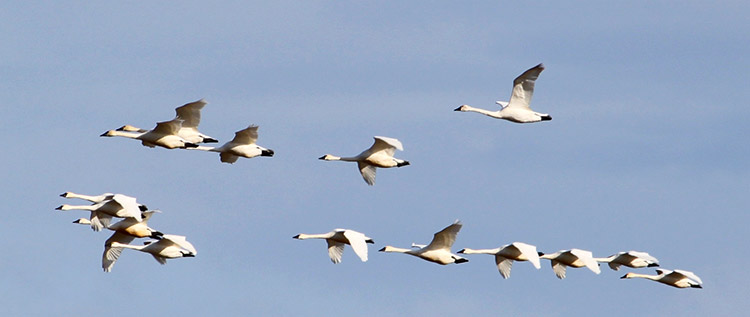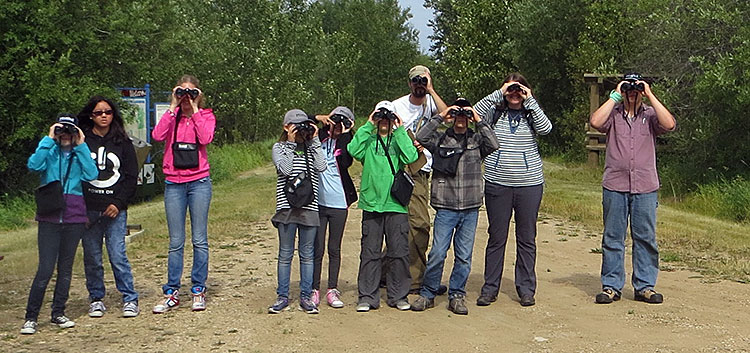Vision
Dedicated to Bird Conservation through Research and Education
Mission
“Our mission is to gain knowledge, understanding and appreciation of boreal birds by monitoring their populations and participating in research; to produce scientifically defensible data; to deliver education programs that foster appreciation of birds and their habitat needs; and to generate awareness/support of the LSLBO within the Lesser Slave Lake region and throughout Canada.”
Where are we?
The Lesser Slave Lake Bird Observatory is located along the eastern shore of Lesser Slave Lake about 20 km north of the town of Slave Lake within the Lesser Slave Lake Provincial Park. It is approximately a 2 ½ hour drive from northwest of the city of Edmonton.
What is special about this location?
Lesser Slave Lake is the second largest lake in Alberta at over 107 km long. The size of the lake acts as a natural barrier for migrating birds, causing them to veer around the lake instead of attempting to cross over the water. Very near to the eastern shore of the lake is Marten Mountain which has an elevation of 1,020 metres above sea level. The mountain serves as another natural barrier that funnels birds directly through the LSLBO monitoring site. This funnelling effect has been coined the “Point Pelee effect” by researchers. On any given spring or fall day, hundreds to thousands of songbirds can be observed migrating through the site. Another reason this location is special is that Lesser Slave Lake was designated as an Important Bird Area (IBA) in the spring of 2000. It received the IBA designation for two reasons; firstly, Tundra Swans concentrate in significant numbers on the lake, with flocks of up to 3500 reported during both spring and fall migrations. And secondly, Western Grebes, which are a species of special concern in Alberta, nest on and around Lesser Slave Lake. For more information please visit http://www.ibacanada.ca/

Tundra Swans
Who are we and how did we come to be?
In 1993 three enthusiastic volunteers conducted a pilot study in the Lesser Slave Lake area to determine if an observatory at Lesser Slave Lake was viable. Results were positive, so in 1994 an independent, non-profit society, the Lesser Slave Lake Bird Observatory, was born. The society was formed and run by a solid group of volunteers from a local bird club. In 1997 the LSLBO was incorporated. Although still directed and run mostly by local volunteers, the organization does currently hire contract and seasonal staff for research and education programs as well as a year-round Executive Director. 
The Lesser Slave Lake Bird Observatory is a proud member of the Canadian Migration Monitoring Network (CMMN). Members of the CMMN track the migration of Canada’s birds in the spring and fall each year, adding to our knowledge of population trends, demographics, phenology, and other essential information about the species that pass through each location. This information is used by governments, environmental organizations, scientists and others to direct our collective actions and improve our ability to conserve Canada’s birds.
The LSLBO is one of only a handful of banding stations located in the Boreal Forest. As such, it is well-positioned to collect critical information on the boreal forest breeding grounds of Neotropical migratory bird species. Its goals are to contribute data to an international effort to determine changes in populations of migratory birds and to document migration at the station itself. Since it was established in 1994, the LSLBO has been involved in many different research and monitoring programs. Migration monitoring is the LSLBO’s core monitoring program but there are also many other programs that take place from spring to fall each year including: the Monitoring Avian Productivity and Survivorship (MAPS) Program and Northern Saw-whet Owl Monitoring. For more information on our other projects please see the monitoring and research section of this site.
The LSLBO is also committed to providing curriculum-based education programs for school groups and community-focused programs and events for the general public. Experienced educators develop and deliver year-round programming on a variety of topics from birds to boreal forest ecology. For more information please visit the education section of this site. The LSLBO’s success would not have been possible without help from our sponsors and especially the partnerships that have been forged with Alberta Parks and the Lesser Slave Forest Education Society. Many thanks go out to all who have helped us get to where we are now.

Banding Lab Tour | Enviroquest Camp
Additional Information for Researchers
If you are a researcher wondering if our data is right for you, please review our Migration Monitoring Read Me document, our detailed Lesser Slave Lake Bird Observatory Standard Operating Protocol, and our Data Sharing Policy.


